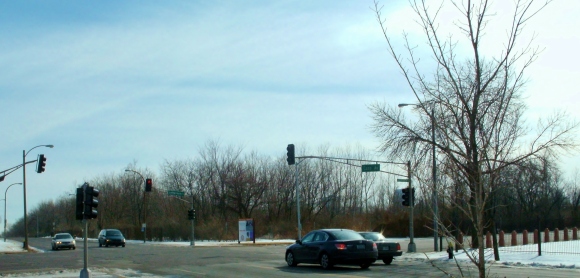Went to the DC Newseum and had a little too much fun in the “be a reporter” exhibit lol But, the seed has long taken root in me for this dream career……. Now I’m just waiting to see the flower that blooms! 🙂
Monthly Archives: December 2012
Hope for Pruitt-Igoe Site; Redeveloper Paul J. McKee Lands Rights
By Evita Caldwell
Forty years after the demolition of the infamous Pruitt-Igoe housing projects, the vacant site where the projects stood may finally start to see life again. Currently the site is forested over with tall trees and weeds. The St. Louis City’s Land Clearance for Redevelopment Authority (LCRA) owns the site, but the site’s redevelopment rights have recently been granted to well-known redeveloper, Paul J. McKee. McKee leads NorthSide Regeneration LLC, the business entity responsible for the redevelopment plan. He believes his redevelopment plan for north St. Louis will be transformational not only for the city, but also for the region and state. While McKee has faced some criticism over his redevelopment efforts, he credits this backlash to critics’ lack of information on his plans for the area. In a quest to complete my series on the future of the former Pruitt-Igoe site, I sat down with McKee in an exclusive interview and got a glimpse of his plans for the site as well as other areas of north St. Louis.
“Beauty draws and fear withdraws.”- Paul J. McKee
When riding through the streets of north St. Louis, one cannot help but notice that the area is heavily blighted. Vacant and dilapidated buildings, closed schools, and lack of businesses serves as evidence that this part of St. Louis suffers from the consequences of urban decay. St. Louis’ population has steadily declined since the 1950s. The most recent census figures have pegged the city’s population at less than 320,000, a stark contrast to the more than 850,000 residents it had at its peak. As the city’s population declined, its economic stability weakened as well. McKee hopes to reverse this trend with his vision for the area, which he says will bring jobs and better housing opportunities for the current and future generations of workers.
The Plan
“The focus is on bringing the up-and-coming generation back to the city. So that when those who are from St. Louis graduate from school, they will be able to seek and find employment here instead of moving out of the city,” McKee says, in reference to the overall root of his plan.
In order to do this, McKee says, he will focus on expanding opportunities for the area’s youth. Currently, the area’s high school dropout rate is significantly greater than the city’s or state’s rate. He hopes to address this disparity by reopening shuttered schools, getting the youth back in school, and sparking excitement about their future because jobs will be waiting for them when they graduate. His plan emphasizes the recruitment of food, energy, water, healthcare, and technology industries to the area. McKee hopes his efforts will spur investment in these areas and encourage business start-ups, which will result in more job opportunities for current and future residents.
Another key hallmark of his redevelopment designs is to bring quality housing to the area
encompassing the former Pruitt-Igoe site. In addition to refurbishing existing homes, his plan calls for constructing modern housing, which will include loft-style single-family residences and condominiums. These housing opportunities will bring St. Louis up to par with other major cities that already have these types of modern housing such as Chicago.
“Beauty draws and fear withdraws. People want to live where the area is beautiful. And if they don’t feel that an area gives them a sense of safety and security, then they won’t want to live there. That is my focus. To get people to want to live in the city again”, McKee says.
McKee’s overall concern is to remove the blight in these areas. Vacant homes will be replaced and current residents who want to remain in the area will receive assistance in bringing their homes up to par, if needed. McKee is also interested in purchasing homes from those who want to sell their homes, but emphasizes that he is not out to displace any resident who chooses to stay in the area.
“I’m not interested in moving people out of their homes. If [current residents] want to keep their homes, we are willing to provide them with whatever help or resources they need so that they can do that,” says McKee, in reference to being accused of eminent domain by critics.
However, there is no doubt that a lot of work is needed in these areas to bring the neighborhoods to a state of “beauty” as McKee envisions. But he is confident that his team can do it.
“There’s no reason that [north St. louis] can’t look as good and do as well as other places in the city [like the Central West End]. That is why my focus is mainly on jobs and education for the youth. With jobs in the area, people can work and have the means to keep their neighborhoods going,” McKee explains.
Light at the End of the Tunnel?
Unfortunately, with blighted communities like north St. Louis, replinishing these areas can be costly. As of right now, McKee is under a two-year option agreement with the city for the rights to the former Pruitt-Igoe site. One of McKee’s current obstacles is that he has to get the funding necessary to clean up the site before any construction can take place. Without the funding, the site risks going undeveloped in the immediate and distant future.
“The location has its challenges. That’s obvious. There’s no telling what’s inside of there,”
McKee says, in reference to the current state of the former Pruitt-Igoe site. “It’s going to take a lot of money and manpower to clean up the site. And right now, we are waiting to see if we can get funding from Tax Increment Financing (TIF) to help us out. So far, we don’t have that, even though the area does meet the qualifications to receive funding under TIF. Unfortunately without the extra funding, I can’t do anything with the site.”
Tax increment financing, commonly referred to as TIF, is a program that uses the future taxes attributable to any new development to help fund public infrastructure improvements in the area. It was created to provide a tool to communities with “blighted areas”. Blight is a term used to describe an area that suffers from extreme deterioration, decay, or unsanitary and unsafe conditions. The former Pruitt-Igoe site undoubtedly fits this description. McKee says that he has his supporters fighting for him to access the TIF program, including
Congressman Lacy Clay and other community leaders in the Carr Square Neighborhood. He is confident that there are even more who want to see the once vibrant and populated area come to life again.
“I pray for revitalization in these areas [I have plans for],” McKee explains. “If I can fix these
areas, I think it will cast the northside [of St. Louis] in a completely different light.”

